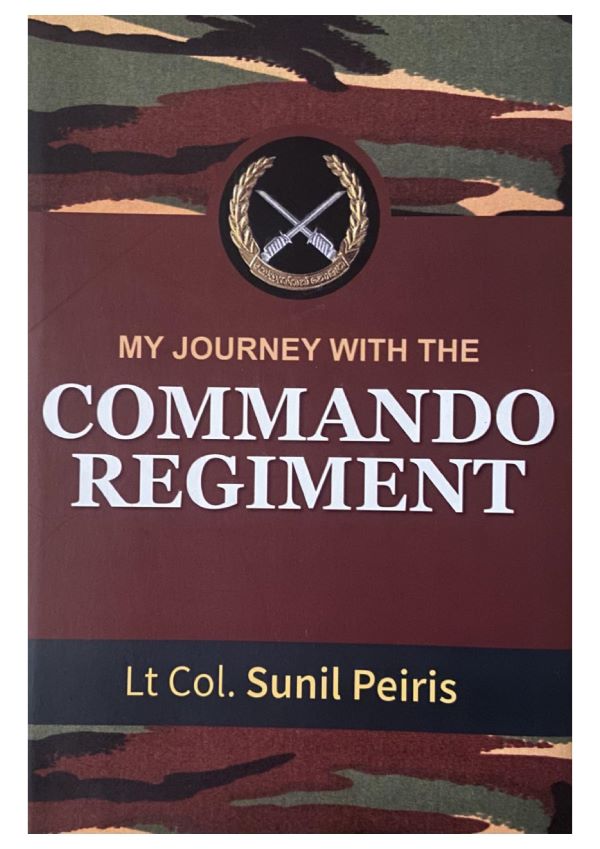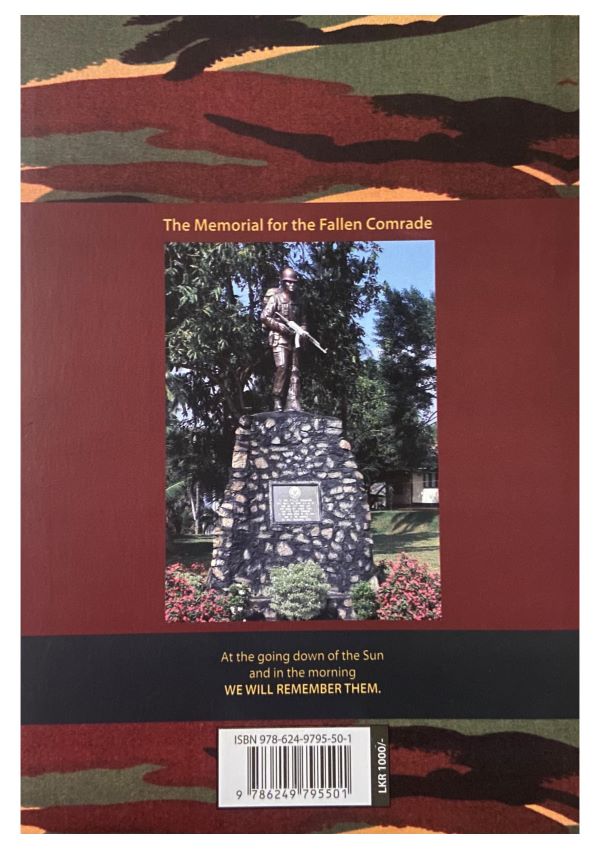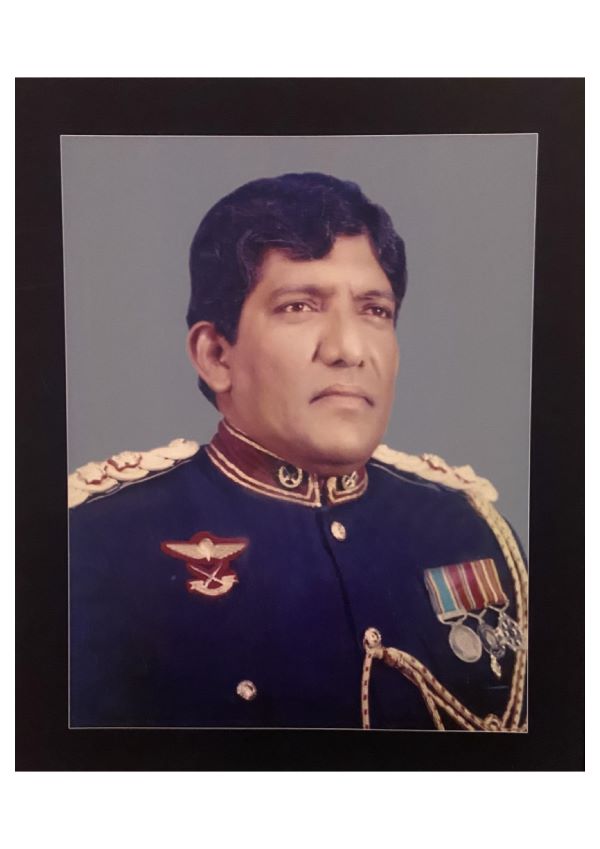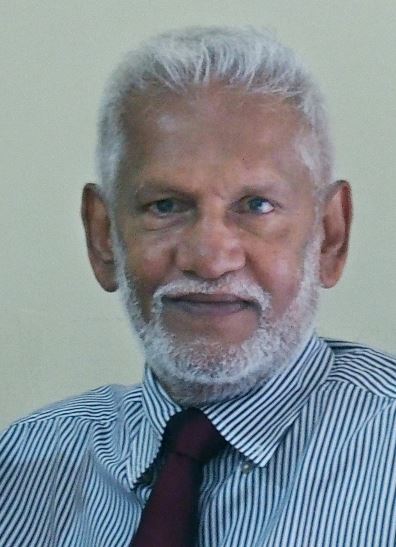A Literary appreciation of the “Commando Regiment” – by Capt Elmo Jayawardena



A Literary appreciation of the “Commando Regiment”
 When the presentation of the book is excellent, a prospective reader would be encouraged to see what is inside. That is where the Colonel won his first round. I will jump over the Author’s writing and talk about the Foreword to the book. It is written by Major General Lalin Fernando. What he wrote reminded me of a similar sentiment I read years ago by Jean-Paul Sartre for the eternally popular ‘Wretched of the Earth’ by Frantz Fanon.
When the presentation of the book is excellent, a prospective reader would be encouraged to see what is inside. That is where the Colonel won his first round. I will jump over the Author’s writing and talk about the Foreword to the book. It is written by Major General Lalin Fernando. What he wrote reminded me of a similar sentiment I read years ago by Jean-Paul Sartre for the eternally popular ‘Wretched of the Earth’ by Frantz Fanon.
General Fernando’s Foreword gives the essence of the story reduced in size but done with military precision. I wasn’t varnishing anything when I linked Sartre and Fanon to the commando book.
Now I come to the photos. The ‘man of the match’ is there, The Colonel, and he is flanked by another Colonel and a Major General. They were regiment leaders. Then comes the ‘salt of the earth’ two Warrant Officers and an elderly Sergeant, the men that mattered.
Right along, the book is filled with what the soldiers of the Commando Regiment did. The braid was there to lead and so were the brave in uniform who fought to the demanding order. It sure is nice to see the recognition spreading from the ranks to the top even before the story begins to unfold.
When I received a gifted copy of the Commando Regiment, courtesy of the author, I noticed an invitation too. It was for the launch of the book at the BMICH. What caught my eye at first glance was the rank and name of the Chief Guest who would grace the occasion. Strangely he was no Julius Caesar nor a local Hannibal. But someone who had served in the Commando Regiment from its inception. Warrant Officer Colin Silva who hails from Tudella was to be the Prima Donna of the event. He’s been the Colonel’s shadow from Day One. Selecting W/O Silva as Chief Guest was not only an honour to him but to all those commandos who toiled, sweated, fought and died for the regiment and the country.
The ‘First Person’ for the event at the BMICH being a Warrant Officer was nothing but a platinum performance by the author. To recognize and honour the ranker who stood by him from the birth of this unit to the day they retired was a magnificent tribute. I salute you Colonel, for your choice of a Chief Guest who has more than earned the laurel than picking one from the “Nodding Crowd” purely for the pomp and pageantry.
That alone made me think of the worth of the man who wrote this book. So, I started reading the story of the Commando Regiment and ‘The Colonel’ who started it all.
The book gives in detail the author’s entry into the military, the usual young blood in search of adventure in a peace-time army. The ambition had been fostered from early teens and shared with younger brother Eksith where they both collected and read and learnt about combat matters and especially about Task Forces around the world trained for dare-devil operations. All that was home-grown till they both joined in tandem the school Cadet Corps that may have cemented the zest they both had to seek carriers in the armed forces.
Young Sunil joined the military. He had been a top all-round student at the school by the beach and reached the pinnacle of being appointed as the Head Prefect. All that you can read in the book including the rigorous training he went through at Diyathalawa to pass out as a Second Lieutenant in the Gemunu Watch.
Next, we see him as a young Captain, 29 years old, and attached to Army Headquarters. One day, out of the blue he gets a message to accompany the head of the Army, General Dennis Perera, to meet the Prime Minister JRJ. The Big shots who flanked the Prime Minister on the power side of the table were the who’s who that ran the country. Some were of the great grade, and some were merely those who thought they were great. I leave you to read the book and do your own separating of the wheat from the chaff.
Our author had been called to set up from the ground-up a Commando Unit, the first of its kind in the country. Captain Peiris was to be the Sisyphus rolling the boulder up the hill. There was one on the Prime Minister’s side of the table who was not from the ‘Dream Team’, Capt Rakitha Wickremanayake. He had just been appointed as the Chairman of the new airline JRJ was planning. The setting up of the Commando Unit was a deterrent to anyone who might highjack a plane of Airlanka, the new airline that was to take wings in an year’s time.
Better read the book and make your own conclusion. This was November 1977. The country was at peace. Prosperity trumpets were blaring away from every orifice like a national anthem. I could not figure out why the high powers wanted to set up a specialized Army unit to protect two secondhand Boeing 707s from being hi-jacked? True the PFLP with the blessings of Yassar Arafat skyjacked jetliners and took them to Dawson’s Field in Jordan and blew them up. Names like Leila Khalid, Carlos the Jackal, Bader Meinhof, Japanese Red Army and ‘freedom fighters’ as such were scaring the skies toting machine-guns. But to carry out that level of terror in peaceful Sri Lanka was hard to imagine. Maybe someone at that power table was hearing the rumble of distant drums blowing across the island from the north?
“We have decided to select you to set up this exclusive unit” (page 43 will tell the reader the rest, I need not elaborate).
Either way, our Captain Peiris was no politician. They wanted a Commando Unit and his job was to obey orders and get the special unit operational. It is clear that Captain Peiris had great respect for his Commander General Dennis Perera and more than that, he knew the integrity of the man and had total confidence that the General would never scapegoat him and sell him down a political drain.
On the other side of the coin was his wife Manisha. I can imagine what role she played in the Commando Unit drama. I have worked with her before and know how valuable her ‘still water’ personality is. Captain Peiris would have received the unstinted support and much needed encouragement as well as the sincere salient criticism from Manisha, the Captain’s Captain.
When reading the book, it was clear to me that the author was a man of deep faith. His reliance on God was a major factor that boosted his confidence in himself. No wonder when the crossroads blocked the path, he knew which way to go.
Setting up an entire new unit in the military was no walk in the park. Amidst a hundred logistical hurdles there were officers with more brass on their shoulders who watched with ‘Argus Eyes’ and wished for the young Captain to faulter and become a defeated orphan. The criticisms came direct and in camouflage. Yet the man had the grit to fight it through and snigger the last laugh. Sunil Peiris had what it takes to survive. General Dennis Perera had chosen wisely a round peg for a round hole that fitted perfectly.
The soldier selection was from people recommended by their respective units. Thirty were chosen, out of which 29 reported. The training started and four dropped out leaving a mere 25 passing out after their final exercise of a march from Inginiyagala to Sigiriya.
The entire planning structure and the detailed training procedures are all in chapter 4 from page 71. Gives the reader a very good idea of how men were moulded to fight the impossible.
The first home of the Commando Unit was established temporarily at Diyathalawa. The numbers were small but well-trained, tinkered and minted to become fierce fighting machines. Reminded me of Thermopylae. The passed out 25 were the first to represent the unit. And the numbers increased as the new recruits added their names to the muster. The operations they carried out and the battles they fought are detailed in the book and makes interesting reading. Very interesting indeed.
The years rolled and the conflict exploded plunging the country into a brutal war of races. The death toll rose on both sides which also included innocent civilians who were caught in the crossfire. The leadership of battle adversaries, often politically motivated, moved their pawns and sent them to die. Some for their country and some for their cause. Simplified – it was our soldiers, their war.
By this time the Commando Unit had moved out of Diyathalawa and found its permanent residence in Ganemulla.
Chapter 13 is about a personal tragedy that the author wrote. Maybe to seek some solace or maybe he just did not want to tell his story without baring what tucked at his very soul. This chapter has nothing to do with the Commando Regiment of the Army. Yet, the Colonel’s inclusion of an event that took place in 1985 in a lonely airfield in Batticaloa is in pages 175-180. I have no heart to write about that. Mine would be meaningless words with hardly any comfort to someone who will carry the sorrow to his grave. I leave you to read and digest how absurd and fickle life could be.
The fighting had intensified, and the political jigsaw puzzle was being fitted by the powers that be with some of the key pieces missing. The IPKF arrived adding a strange dimension to the already abstract equation. Parents buried children, what did it matter whether they were Sinhalese or Tamil? I clearly remember the times, the mid-80s and what a political mess it was. The Commando Unit increased in strength and was in the forefront fighting the enemy and protecting civilians.
The Colonel left the Army in 1988. Whichever way you look at it, the parting was a sad farewell to a dedicated career soldier. The band played ‘Auld Lang Syne’ and the ‘Father of the Regiment’ took his last salute from the Commandos in the Ganemulla Camp and walked to his jeep and was driven away.
The reason was nothing strange. It was purely political.
In 2009 when the guns went silent in Nandikadal the commandos went back to Ganemulla. What started with 25 soldiers in 1978/79 had grown to four regiments of tough men who wore the maroon beret. Some had died for their country, 43 officers and 689 other ranks. Some suffered injuries and were marked for life. There were 49 officers and 890 soldiers among them. Such figures are on record. My fervent wish is the continued remembrance of the sacrifices they made.
Maybe not now, but in the coming years,
Possibly in a better land, without conflict and corruption, but in lasting peace
We might recall the swollen mounds that buried the unknown soldier,
Or a cemetery memorial of a lost young life
At such times we could imagine the meaning of the shed tears
Perhaps then, we will understand.
Capt Elmo Jayawardena







